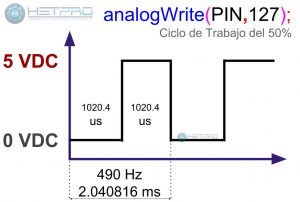
- #Arduino analogwrite precision software#
- #Arduino analogwrite precision code#
- #Arduino analogwrite precision plus#
The effective output impedance will be very low (your 60 Ohm is before 100% negative feedback, so the real Zout will be much less than 1 Ohm )įirst thing is to make sure you have a proper power supply and when that's done, I think the rest will follow by itself.Before proceeding with this tutorial you should have the ESP32 add-on installed in your Arduino IDE. While twisting the wire can reduce radiated noise effects (if using long wires), there's no need for a differential amplifier/buffer. supply terminals of each goes all the way to the supply, rather than being fed of one another) and make it with proper filtering, then one board can sag its supply without much influence on the other - just keep a good low impedance ground (with each terminated at the supply as well). If you feed both boards directly from your power source (i.e. 5mV too little) the problem is likely offset, which can be trimmed out (10k trimmer from pin 1 to pin 5 with the wiper to pin 4). If the error is a steady measure over the entire range (like e.g. The output impedance of the CA3140 is around 60 Ohms, very high in this day and age, but even that shouldn't matter, as the feedback includes this in the loop.


I assume the loading that you mention, is without the buffer(?) as even the worst present day DMMs has an input impedance of 1M (10M on most).
#Arduino analogwrite precision code#
Perhaps this has already been done before? Anyway, it is a nifty little circuit and code that I am using in a couple of practical circuits, mainly as a simple way of sending information between Arduino's as an analog voltage.ĬA3140 (and the dual version CA3240) is still a great op-amps within their capabilities, but unfortunately, the price has sky-rocketed, at least in DK, which is pretty odd, when you can get good (/better) replacements much cheaper. Even so, there can be some errors with the ADC on an arduino so to improve this, take twenty samples and take the average. Stray RF can be an issue so it helps to keep the leads short. The self discharge of a greencap polyester capacitor or a tantalum means that 1 microsecond adjustments are only needed every five or ten seconds. Settling time is around 1 millisecond which is 100,000 times faster than using a large RC on pwmout. Sample the voltage on the capacitor, rapidly charge or discharge to near the correct value, eg 50 millivolts, then apply brief charge or discharge pulses of around 1 microsecond to keep the value correct.
#Arduino analogwrite precision software#
This circuit does all the clever work in software and uses a 10k resistor and a 1uF greencap capacitor.
#Arduino analogwrite precision plus#
Adding a very large RC filter (eg 100k and 100uF) means it can be ten seconds for the output to stabilise, plus you have to be careful about internal leakage within the capacitor, using tantalum capacitors instead of electrolytics. Fancy multipole filters use lots of components. If you add a standard RC low pass filter to the pwmout signal on an arduino the output looks noisy on a CRO, and fluctuates considerably if another arduino samples the voltage. The project uses only one resistor and one capacitor and one arduino pin, and uses a software trick where an analog input pin can be turned into an output, then used to charge or discharge a capacitor, and then turned back into an input to read back the value. This project improves the resolution for an analog output to around 10 bits, plus has a much faster settling time and allows up to six analog outputs. Standard pwm output from the Arduino has an 8 bit resolution.


 0 kommentar(er)
0 kommentar(er)
